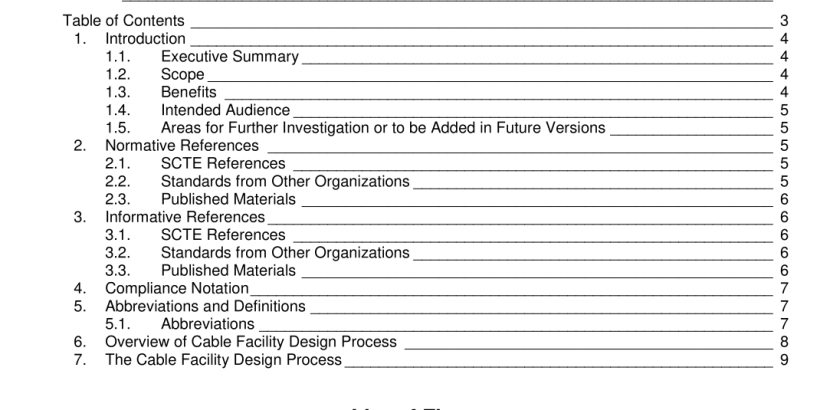ANSI SCTE 229-2016 pdf download.Operational Practice for Cable Facility Design Process
Implicit in the resulting design will be specific types and configurations of physical, electrical and mechanical infrastructure chosen to achieve a designated level of availability of such infrastructure to support delivery of services to customers. As such, this OP can be considered a companion to the SCTE Standard EMS-025, which specifies certain of the criteria noted above. As well, the resulting facility design will be characterized by its conformance to the SCTE Standard EMS-025. This OP describes each criteria noted above in terms of specific activities comprising the process. Each activity is characterized as one or more questions about the facility which must be answered in order to realize an optimal design for the facility.
1.2. Scope
This document addresses the design of cable facilities that house inside plant equipment which is part of the network through which services are delivered to customers. It is noted that a single building may include both technical and non-technical facilities. Non-technical facilities would include, for example, general office, warehouse, technical operations, and customer service counters. The Operational Practice for Cable Facility Design Process does not address the design on non-technical spaces, however the fundamental OP described in this document can be applied to non- technical spaces. And, for facilities that include both technical and non-technical facilities, the design of the entire facility is best conducted using the Operational Practice for Cable Facility Design Process, given that the technical facility component demands higher standards of design and construction, and is most immediately important to the delivery of services.
1.3. Benefits
Through the application of the Operational Practice for Cable Facility Design Process, the cable operator can best realize improved ability to remain competitive, particularly with respect to non-facilities-based service providers, by being able to deploy new and more attractive services/products to existing and new customers as a result of having well-designed, capable cable facilities in place that support, not hinder, the installation of network equipment in support of such services.
1.4. Intended Audience
The primary intended audience for the OP is cable operator personnel having responsibility for inside plant network engineering and implementation, as well as cable operator personnel having responsibility for the construction and operation of cable facilities. Secondarily, the intended audience includes any cable operator personnel having in interest in the design, construction, operation, and use of a cable facility. Such would include personnel in corporate and regional finance groups, technical operations groups, and groups responsible for products and services. Finally, the intended audience also includes professionals outside of the cable operator who provide design, engineering, project management and other professional services to the cable operator with respect to cable facilities. Such professionals include licensed architects, professional engineers (e.g. electrical, mechanical, structural, civil), urban planners, and specialty consultants, all of whom are trained and skilled in the design and implementation of buildings and may, or may not, have immediate experience with the designing and implementing cable facilities for cable operators.
For every participant in the process, it is critical to know who the parties are, and what each is professionally qualified to speak about. Further, it is critical to have a solid basis of fact describing how the facility supports the business (i.e. the making of money) in order to negotiate successfully with all the parties. The process is presented at very high level in order to afford the reader an understanding of broader context in which any facility design effort must exist. Naturally, the process will tend to be somewhat simplified with respect to smaller, less complex facilities, and will tend to be a more significant undertaking with respect to major facilities, such as Classes A and B. With increased complexity comes a longer time frame for completing the design process. The time frame, just for design, not construction, can be as short as several months to as long as a few years. It is reasonable to expect that larger, more expensive facilities will be more complex and take longer to design. However, it is quite often the case that smaller, seemingly simpler facilities can be affected by conditions (e.g. zoning by-laws) that make the design process far more complex than would otherwise be expected, thus much more time consuming. Regardless of anticipated overall complexity, each element of the design process can be a very complex effort. For any facility project, the design process can be successful only with the appropriate degree of participation of the necessary parties inside the cable operator and with the engagement of professional architects, engineers and planners.ANSI SCTE 229-2016 pdf download
